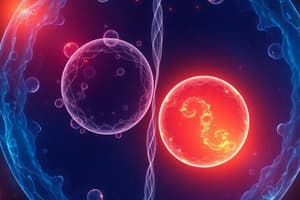Podcast
Questions and Answers
What is the primary purpose of meiosis in organisms?
What is the primary purpose of meiosis in organisms?
- To repair damaged tissues in somatic cells
- To replicate cells for asexual reproduction
- To introduce genetic variation through sexual reproduction (correct)
- To produce two identical daughter cells for growth
During which phase of meiosis do homologous chromosomes align at the metaphase plate?
During which phase of meiosis do homologous chromosomes align at the metaphase plate?
- Prophase II
- Telophase II
- Metaphase I (correct)
- Anaphase I
What is the end result of meiosis after two rounds of division?
What is the end result of meiosis after two rounds of division?
- One diploid and one haploid daughter cell
- Two diploid daughter cells
- Four genetically distinct haploid daughter cells (correct)
- Four genetically identical diploid cells
Which of the following statements about telophase I of meiosis is accurate?
Which of the following statements about telophase I of meiosis is accurate?
Which phase of prophase I involves the exchange of genetic material between homologous chromosomes?
Which phase of prophase I involves the exchange of genetic material between homologous chromosomes?
What is the main purpose of meiosis compared to mitosis?
What is the main purpose of meiosis compared to mitosis?
Which statement accurately describes the occurrence of chiasmata during meiosis?
Which statement accurately describes the occurrence of chiasmata during meiosis?
How does the chromosome number of daughter cells after meiosis differ from those after mitosis?
How does the chromosome number of daughter cells after meiosis differ from those after mitosis?
What occurs during diplotene of prophase I in meiosis?
What occurs during diplotene of prophase I in meiosis?
Which feature is not characteristic of mitosis?
Which feature is not characteristic of mitosis?
Study Notes
Mitosis and Meiosis Comparison
- Mitosis is primarily for growth, repair, and asexual reproduction; meiosis introduces genetic variation through sexual reproduction.
- Mitosis produces two genetically identical diploid daughter cells; meiosis results in four genetically distinct haploid daughter cells.
- Mitosis involves one division; meiosis consists of two divisions.
Sequential Phases of Meiosis
Meiosis I
- Prophase I: Homologous chromosomes pair and exchange genetic material via crossing over; the nuclear envelope disintegrates, and spindle forms.
- Metaphase I: Homologous chromosomes align at the metaphase plate with spindle fibers attached.
- Anaphase I: Homologous chromosomes (not sister chromatids) are pulled to opposite poles.
- Telophase I: Chromosomes reach poles, decondense, followed by cytokinesis resulting in two haploid daughter cells.
Meiosis II
- Prophase II: Chromosomes condense again; spindle apparatus re-forms in each haploid daughter cell.
- Metaphase II: Chromosomes align at the metaphase plate; spindle fibers attach to centromeres.
- Anaphase II: Sister chromatids are pulled apart to opposite poles.
- Telophase II: Chromatids arrive at the poles, decondense, and the nuclear envelope reforms, followed by cytokinesis leading to four haploid daughter cells.
Subphases of Prophase I
- Leptotene: Chromosomes condense and are visible; each chromosome is made of two sister chromatids.
- Zygotene: Homologous chromosomes pair through synapsis aided by the synaptonemal complex, forming tetrads.
- Pachytene: Further condensation occurs and crossing over takes place, increasing genetic diversity.
- Diplotene: Synaptonemal complex disassembles; homologous chromosomes begin to separate while remaining at chiasmata.
- Diakinesis: Chromosomes condense maximally; the nuclear envelope breaks down, and chiasmata move toward chromosome ends, indicating preparation for segregation.
Differences Between Mitosis and Meiosis
- Number of Divisions: Mitosis has one division; meiosis has two.
- Number of Daughter Cells: Mitosis results in two daughter cells; meiosis results in four.
- Genetic Variation: Mitosis produces identical daughter cells; meiosis leads to genetic diversity via crossing over and independent assortment.
- Chromosome Number: Mitosis maintains diploid chromosome number; meiosis halves the chromosome count (haploid).
- Purpose: Mitosis is aimed at growth and repair; meiosis is for sexual reproduction and evolution.
- Synapsis Occurrence: Synapsis and crossing over occur only in meiosis; not in mitosis.
- Cell Type: Mitosis involves somatic cells; meiosis involves germ cells.
Similarities Between Mitosis and Meiosis
- Both processes begin after the S phase, where the genetic material is duplicated.
Chromosome Content After Division
- Mitosis: Daughter cells retain the diploid chromosome count (2n); in humans, this is 46 chromosomes (23 pairs).
- Meiosis: Each daughter cell ends up with half the chromosome count, resulting in haploid cells.
Studying That Suits You
Use AI to generate personalized quizzes and flashcards to suit your learning preferences.
Description
This quiz explores the key differences between mitosis and meiosis, summarizing their steps, purposes, and outcomes. Understand the processes involved in cell division and the significance of genetic variation introduced by meiosis. Perfect for biology students looking to solidify their knowledge of cellular reproduction.





